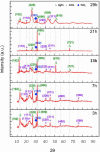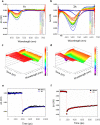Strong coupling of hybrid states of light and matter in cavity-coupled quantum dot solids
- PMID: 37794042
- PMCID: PMC10551025
- DOI: 10.1038/s41598-023-42105-1
Strong coupling of hybrid states of light and matter in cavity-coupled quantum dot solids
Abstract
The formation of plasmon-exciton (plexciton) polariton is a direct consequence of strong light-matter interaction, and it happens in a semiconductor-metal hybrid system. Here the formation of plasmon-exciton polaritons was observed from an AgTe/CdTe Quantum Dot (QD) solid system in the strong coupling regime. The strong coupling was achieved by increasing the oscillator strength of the excitons by forming coupled QD solids. The anti-crossing-like behaviour indicates the strong coupling between plasmonic and excitons state in AgTe/CdTe QD solids, resulting in a maximum Rabi splitting value of 225 meV at room temperature. The formation of this hybrid state of matter and its dynamics were studied through absorption, photoluminescence, and femtosecond transient studies.
© 2023. Springer Nature Limited.
Conflict of interest statement
The authors declare no competing interests.
Figures









References
-
- Vasa P. Strong light-matter interaction. Digital Encycl. Appl. Phys. 2019 doi: 10.1002/3527600434.eap828. - DOI
-
- Pereira RMS, Borges J, Smirnov GV, Vaz F, Vasilevskiy MI. Surface plasmon resonance in a metallic nanoparticle embedded in a semiconductor matrix: Exciton-plasmon coupling. ACS Photon. 2019;6:204–210. doi: 10.1021/acsphotonics.8b01430. - DOI
-
- Rodarte AL, Tao AR. Plasmon-exciton coupling between metallic nanoparticles and dye monomers. J. Phys. Chem. C. 2017;121:3496–3502. doi: 10.1021/acs.jpcc.6b08905. - DOI
Grants and funding
LinkOut - more resources
Full Text Sources

